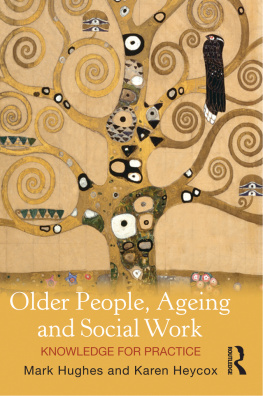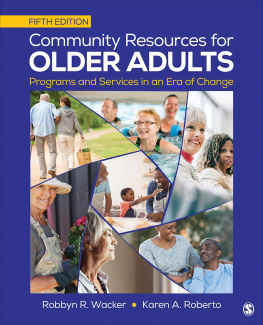GARLAND STUDIESON
THE ELDERLY IN AMERICA
edited, by
STUART BRUCHEY
ALLAN NEVINS PROFESSOR EMERITUS COLUMBIA UNIVERSITY
PORTRAYING OLDER PEOPLE IN ADVERTISING MAGAZINE, TELEVISION, AND NEWSPAPERS
________________
THOMAS E. ROBINSON II
First published 1998 by Garland Publishing, Inc.
This edition first published in 2021 by Routledge
605 Third Avenue, New York, NY 10017
and by Routledge
2 Park Square, Milton Park, Abingdon, Oxon OXl 4 4RN
Routledge is an imprint of the Taylor & Francis Group, an informa business
Copyright 1998 Thomas E. Robinson II
All rights reserved. No part of this book may be reprinted or reproduced or utilised in any form or by any electronic, mechanical, or other means, now known or hereafter invented, including photocopying and recording, or in any information storage or retrieval system, without permission in writing from the publishers.
Notice:
Product or corporate names may be trademarks or registered trademarks, and are used only for identification and explanation without intent to infringe.
Disclaimer
The publisher has made every effort to trace copyright holders and welcomes correspondence from those they have been unable to contact.
Publishers Note
The publisher has gone to great lengths to ensure the quality of this reprint but points out that some imperfections in the original copies may be apparent.
Library of Congress Cataloging-in-Publication Data
Robinson, Thomas E., 1962-
Portraying older people in advertising : magazine, television, and newspapers I Thomas E. Robinson IL
p. cm. - (Garland studies on the elderly in America)
Includes bibliographical references and index.
ISBN 0-8153-3215-7 (alk. paper)
1. Aged in advertising-United States. I. Title. IL Series.
HF5813.U6R55 1998
659.1-dc21
98-31556
ISBN 13: 978-1-03-216590-5 (hbk) ISBN 13: 978-1-03-216737-4 (pbk) ISBN 13: 978-1-00-324971-9 (ebk)
DOI: 10.4324/9781003249719
Dedicated to my family, Theresa, Meagan, Trey, and Charlie. Without their love and encouragement I would not have been able to devote the necessary time and effort into completing this research and my degree. I love them with all my heart and could never thank them enough for their patience, understanding, and willingness to follow me across the United States. Also, to my mother and father who always believed that I could Do It!
Contents
- REVIEW OF LITERATURE
- Older Individuals on Television
- Older Individuals in Magazine Advertising
- Older Individuals on Television Advertisements
- Older Individuals Response to Advertising
- METHODOLOGY
- Explaining the Coding Instrument
- Magazines
- Newspapers
- Television
- ANALYSIS OF DATA
- Introduction
- Results of the Coding Instrument Pretest
- Results of Intercoder Reliability
- Results of the Research Questions
- SUMMARY AND CONCLUSIONS
- Summary and Examples
- Conclusions
- Limitations of Study
- Future Research
Figures
Tables and Appendices
TABLES
- Independent Coder Reliability of Content Analysis
- Total Number Advertisements with People and Older Individuals in the Media
- Total Number of People and Older Individuals in the Media Advertisements
- Total Number of Older Individuals by Gender
- Total Number of Advertisements Targeting the Different Market Segments
- Advertised Products Targeting the Older Market
- The Older Characters Roles in the Advertisements
- Type of Person the Older Person Was Cast in the Advertisements
- Physical, Mental, or Personality Traits of the Older Characters
- Placement of the Older Person with Others in the Advertisements
- Setting in which the Older Characters Were Placed in Advertisements Targeting the Older Market
- Overall Portrayals of the Older Characters in Advertisements Targeting Each Market
APPENDICES
Acknowledgments
There are many people I wish to thank for contributing their time and efforts to help me complete this dissertation. I would first like to thank the five members of my dissertation and academic committee Dr. Tommy Smith, Dr. Gene Wiggins, Dr. J. T. Johnson, Dr. Mazharul Haque, and Dr. Stan Gwin.
Second, I would like to thank my buddies, good friends, and colleagues Tony DeMars and Rick Duet. With their help, friendship, and hours of collaboration I made it through the program with a smile on my face. Whenever I needed help with anything one of them was there. I look forward to working with each of them in our professional careers as we continue to strive for the TTU and LWT (the level by which all success is measured).
Finally, I would like to thank my wife, Theresa, for the many hours she gave of herself to help me earn my degree. Theresa was my secretary, coder, gopher, motivator, coach, data entry operator, slave driver, proofreader, partner, and friend. She was truly my inspiration.
Portraying Older People in Advertising
CHAPTER 1 Introduction
DOI: 10.4324/9781003249719-1
Todays television viewer is led to believe that most older Americans:
Are alike;
Are institutionalized
Are in poor health
Are senile, constipated, or incontinent; and
Are either extremely poor or very wealthy
... these myths and stereotypes are plain wrong.
Not only are they wrong, they convey a negative picture of aging which leads many Americans to view growing older with disdain and dismay. If we buy into the role models we see on television, we may begin to behave accordingly and begin to become burdens on societynot useful, productive, vital contributors.
(Horace B. Deets, 1993, Executive Director, American Association of Retired Persons).
As society grows and changes, advertisers are faced with the challenge of matching their advertising messages to new and different target audiences. For example, children, adolescents, men, women, and older individuals are all audiences with specific needs, wants, and desires that advertisers must address in their advertising appeals. In addition to changing markets, advertisers are working with a media system that is continually growing and diversifying. The new media include a larger number of channels through cable and satellite systems, a variety of narrow-cast programming, the Internet, direct response television, and the increasing use of video recorders to view movies and record television shows.
One subgroup that seems to be changing and growing very rapidly is the older Americans, which includes those individuals 65 years or older (Bureau of Labor Statistics, 1984, as cited in Lazer & Shaw, 1987; ; Schick, 1986).

Figure Actual and projected growth of the older population, 1900-2050.
(U.S. Bureau of the Census, 1982 as cited in Schick, 1986; United Nations, 1991 as cited by )
These figures indicate that older individuals are a large percentage of the overall population with considerable growth potential over the next 25 years. In fact, as the older population continues to grow, its members will begin to outnumber the teenagers of America by a 2-to-1 ratio ().









